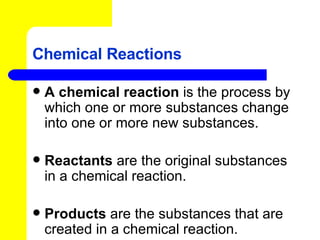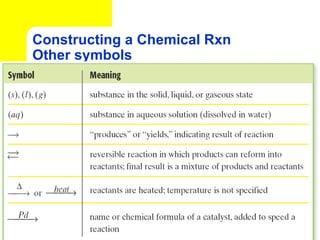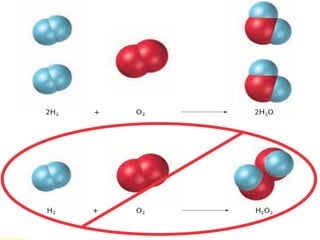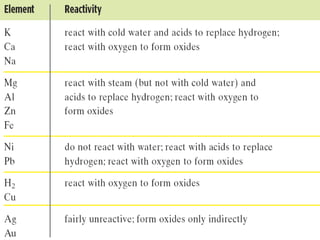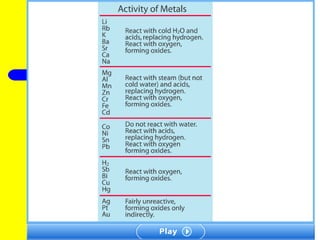Chapter 8
- 1. Chapter 8 Describing Chemical Reactions
- 2. Making Chili 1 lb browned hamburger 16 oz can tomato sauce 2 – 16 oz cans of red kidney beans 1 lb chopped onion 3 chopped green peppers 3 cloves fresh garlic ½ cup chili powder 2 tbsp olive oil
- 3. Chemical Reactions A chemical reaction is the process by which one or more substances change into one or more new substances. Reactants are the original substances in a chemical reaction. Products are the substances that are created in a chemical reaction.
- 4. Chemical Reactions How to make chili Ingredients + heat chili How to make water 2 H 2 + O 2 2 H 2 0 Reactants Products
- 6. Evidence of a chemical change
- 7. Evidence of a chemical change
- 8. Evidence of a chemical change
- 9. Chemical v. Physical chemical change – new substance forms with properties that differ from original substance density boiling point melting point physical change - changes of state evaporation condensation melting freezing
- 10. Constructing a Chemical Rxn A chemical equation shows the chemical formulas and relative amounts of all reactants and products. A word equation contains the names of the reactants and products. Equations must be balanced .
- 11. Constructing a Chemical Rxn Word Equation methane + oxygen carbon dioxide + water Formula Equation CH 4 + O 2 CO 2 + H 2 O
- 12. Constructing a Chemical Rxn Other symbols
- 14. Chapter 8 The Great Balancing Act
- 16. Think… Law of Conservation of Mass states that mass cannot be created or destroyed by a chemical or physical change Therefore, ALL chemical equations must be balanced . That is, having the same number of atoms on both sides of the arrow
- 18. Balancing Equations The number of atoms for each element must be the same on the reactants’ side and on the products’ side. A coefficient multiplies the number of atoms of each element in the formula that follows. H 2 O: 2 hydrogen atoms, 1 oxygen atom 2 H 2 O: 4 hydrogen atoms, 2 oxygen atoms
- 21. Sample Problem Balance the equation for the reaction of iron (III) oxide with hydrogen to form iron and water.
- 22. Sample Problem Aluminum reacts with arsenic acid, HAsO 3 , to form H 2 and aluminum arsenate. Write a balanced equation for this reaction.
- 23. Summarize the steps 1. NEVER CHANGE CHEMICAL FORMULAS! 2. Draw a table that shows the number of atoms before and after the arrow 3. Change the equation so that the number of each element are the same before and after the equation. Do this by adding COEFFICIENTS 4. Redo the table to match change, and repeat as needed.
- 24. Chapter 8 Reaction Types
- 25. The 5 Reaction Types
- 26. Synthesis Reactions In a synthesis reaction a single compound forms from two or more reactants. Two elements form a binary compound C + O 2 CO 2 2C + O 2 2CO Two compounds form a ternary compound CaO( s ) + H 2 O( l ) Ca(OH) 2 ( s ) CO 2 ( g ) + H 2 O( l ) H 2 CO 3 (aq )
- 28. Decomposition Reactions In a decomposition reaction a single compound breaks down, often with the input of energy, into two or more elements or simpler compounds. Decomposition of water electricity heat CaCO 3 ( s ) CaO( s ) + CO 2 ( g ) A metal carbonate decomposes to form a metal oxide and carbon dioxide. 2H 2 O( l ) O 2 ( g) + 2H 2 ( g )
- 31. Sample Problem Predict the product(s) and write a balanced equation for the reaction of potassium with chlorine.
- 32. Double-Displacement Reactions In a double-displacement reaction two compounds in aqueous solution appear to exchange ions and form two new compounds. One of the products must be a solid precipitate, a gas, or a molecular compound, such as water. HCl( aq ) + NaOH( aq ) HOH( l ) + NaCl( aq )
- 35. Displacement Reactions In a displacement reaction a single element reacts with a compound and displaces another element from the compound. 2Al( s ) + 3CuCl 2 ( aq ) 2AlCl 3 ( aq ) + 3Cu( s ) Aluminum displaces copper.
- 39. Sample Problem Determining Products by Using the Activity Series Magnesium is added to a solution of lead(II) nitrate. Will a reaction happen? If so, write the equation and balance it.
- 40. Combustion Reactions A combustion reaction is a reaction of a carbon based compound with oxygen. Combustion of propane C 3 H 8 + 5O 2 3CO 2 + 4H 2 O Combustion of ethanol CH 3 CH 2 OH + 3O 2 2CO 2 + 3H 2 O


